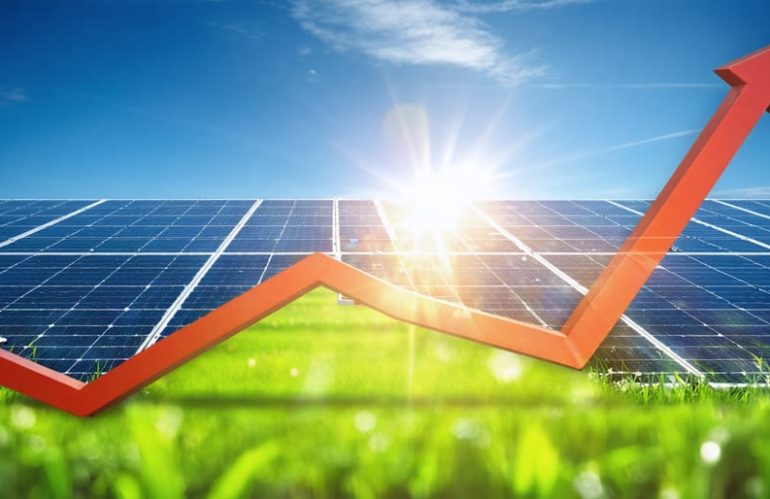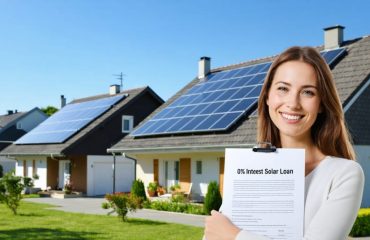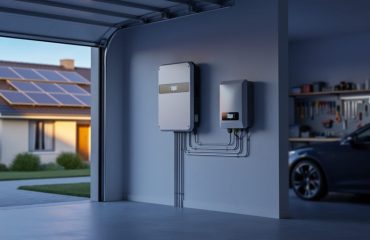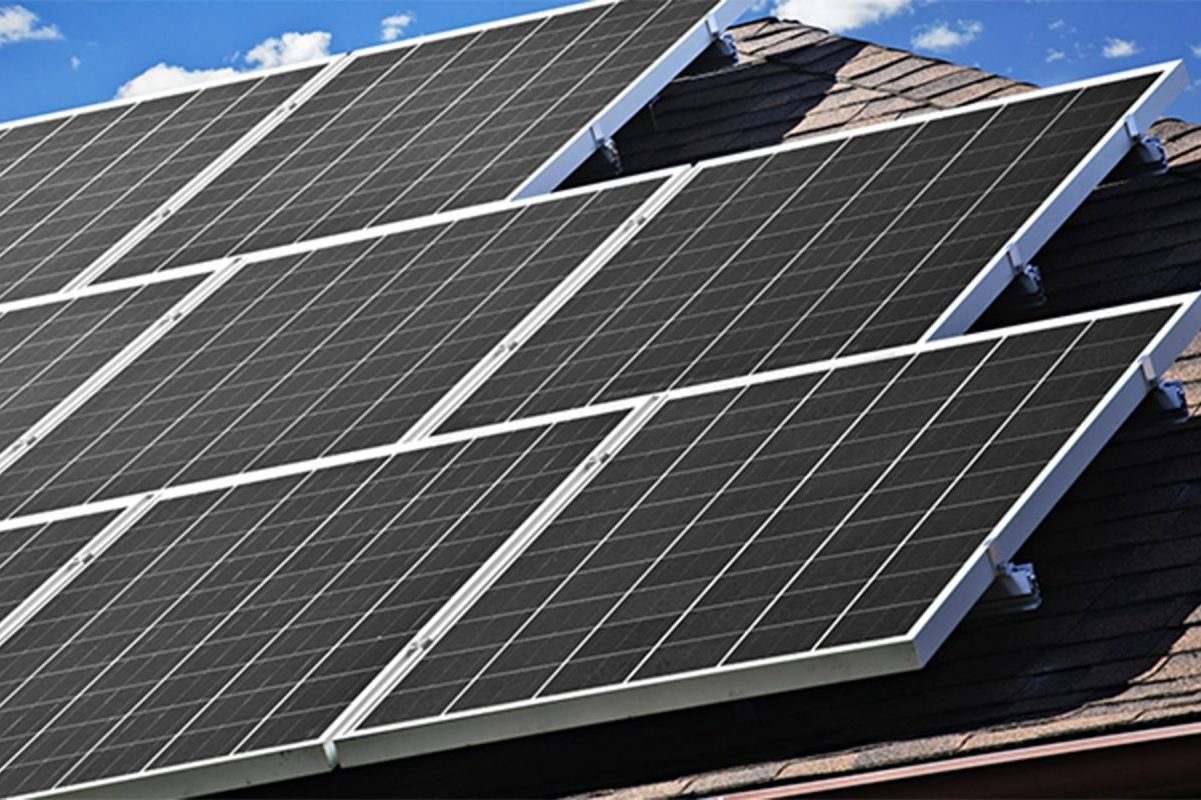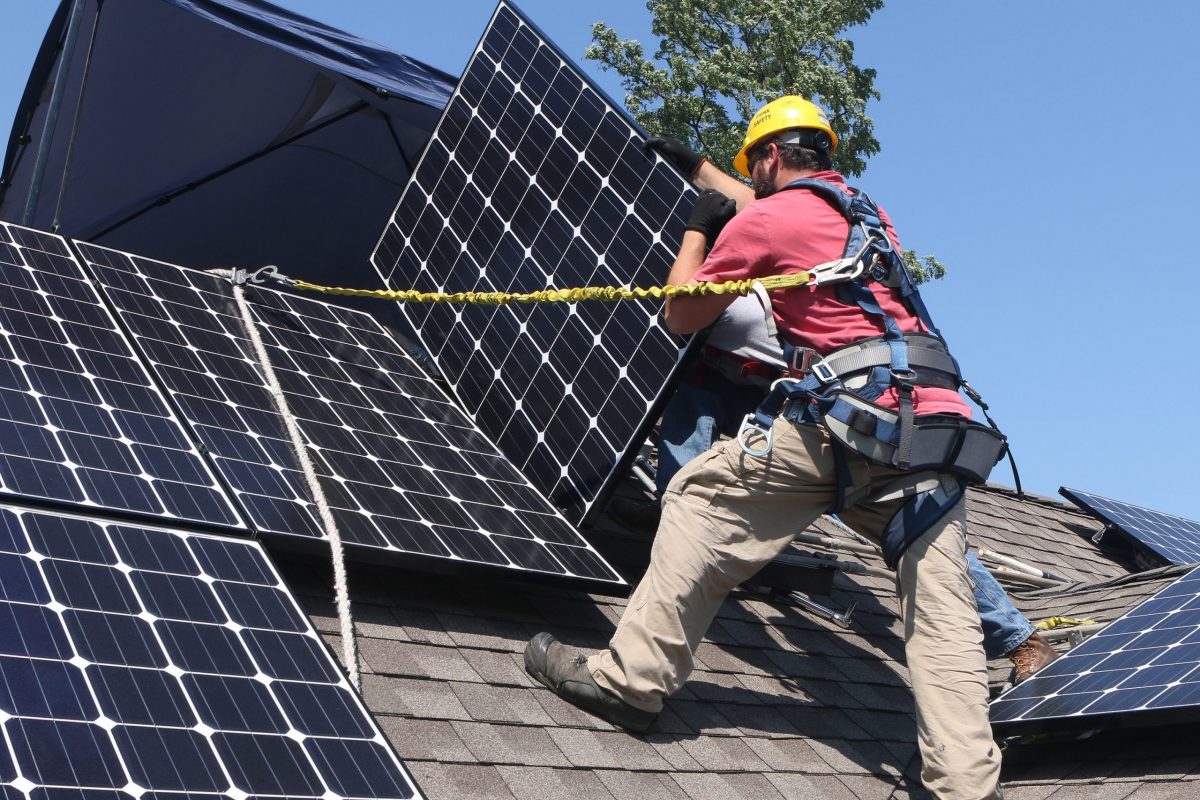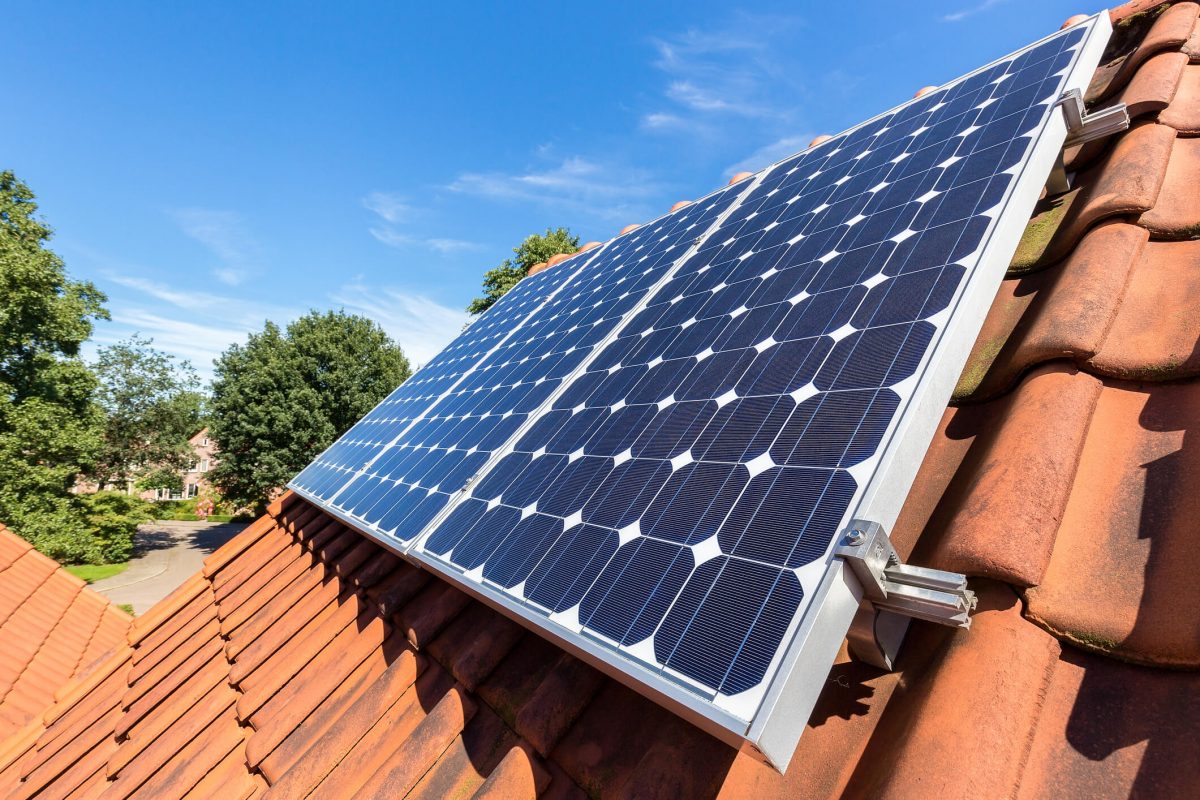Solar panels deliver more than just environmental benefits – they’re a smart financial investment that can generate returns of 15-25% annually on your home. With utility costs rising by an average of 4.3% yearly, installing solar panels typically pays for itself within 5-8 years while providing 20+ years of reliable energy savings. Modern installations cost 70% less than a decade ago, and combined with federal tax credits covering 30% of installation costs through 2032, the financial case for solar has never been stronger. Whether you’re looking to boost property value, slash monthly bills, or secure energy independence, understanding solar ROI helps you maximize returns on this sustainable home upgrade. This guide breaks down the key factors affecting solar panel payback periods and shows you how to optimize your investment for maximum financial benefit.
Understanding Solar Panel ROI Basics
Initial Investment Breakdown
Understanding the long-term ownership costs of solar panels starts with a clear breakdown of your initial investment. The average residential solar installation typically ranges from $15,000 to $25,000 before incentives. This total comprises several key components:
Equipment costs usually account for about 50% of your investment, including solar panels ($5,000-$8,000), inverters ($1,000-$2,000), and mounting hardware ($500-$1,000). Premium panels from top manufacturers like LG or SunPower may cost more but often deliver better efficiency.
Installation labor makes up roughly 35% of the total cost, ranging from $5,000 to $7,000, depending on your roof’s complexity and local labor rates. This includes professional mounting, electrical work, and system testing.
The remaining 15% covers permits, inspections, and administrative costs. Expect to pay $500-$1,000 for local building permits, $200-$400 for electrical permits, and additional fees for utility interconnection approval. While these costs might seem substantial, remember that federal tax incentives and local rebates can significantly reduce your out-of-pocket expenses.
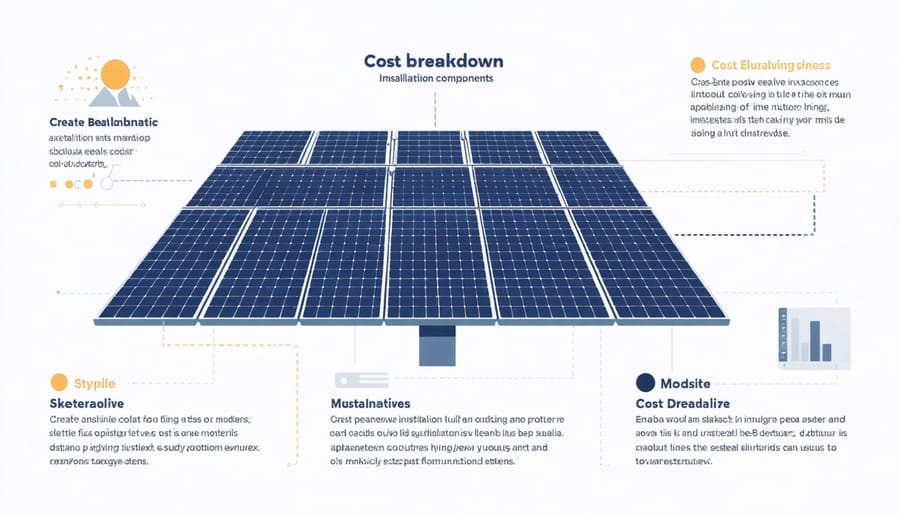
Financial Benefits and Savings
Installing solar panels offers multiple paths to financial returns, making it an attractive investment for homeowners. The most immediate benefit is the reduction in monthly electricity bills, with many households seeing savings of 50-90% on their utility costs. Over time, these monthly savings add up to significant amounts, often reaching tens of thousands of dollars over the system’s lifetime.
Net metering programs allow homeowners to sell excess electricity back to the grid, creating an additional revenue stream. Many states and utility companies offer generous incentives, including tax credits, rebates, and performance-based incentives that can significantly reduce the initial installation costs.
Solar panels also increase property value, with studies showing homes with solar installations selling for 4.1% more on average than comparable non-solar homes. This translates to an additional $9,500 for the median-valued home in the U.S.
The financial benefits extend beyond direct savings. Solar installations protect against rising electricity rates, effectively locking in energy costs for 25-30 years. Additionally, some states offer Solar Renewable Energy Credits (SRECs), which homeowners can sell for extra income, further enhancing the overall return on investment.
Maximizing Your Solar Panel Returns
Optimal System Sizing
Determining the right size for your solar panel system is crucial for maximizing your return on investment. The key is to find the sweet spot between your energy needs and available roof space without overbuilding.
Start by analyzing your past 12 months of electricity bills to understand your average monthly consumption. This baseline helps calculate the system size needed to offset your energy usage. Most homeowners aim to cover 80-100% of their electricity needs, as this typically provides the best financial returns.
Consider these factors when sizing your system:
– Available roof space and orientation
– Local sunshine hours and weather patterns
– Current electricity consumption
– Future energy needs (like electric vehicles)
– Local utility policies and net metering rules
– Budget constraints
A common mistake is installing an oversized system that generates more power than you can use or get compensated for. Instead, focus on matching your actual needs. For most single-family homes, a system between 5-10 kW is typically sufficient, though this varies by region and consumption patterns.
Work with a qualified solar installer who can perform a detailed site assessment and energy analysis. They should provide multiple system size options with corresponding ROI calculations, helping you choose the most cost-effective solution for your specific situation. Remember that bigger isn’t always better – the goal is to optimize your investment returns while meeting your energy needs.
Available Incentives and Tax Benefits
The federal government currently offers a significant 30% tax credit through the Investment Tax Credit (ITC) program, making solar tax incentives more attractive than ever. This means homeowners can deduct nearly one-third of their total solar installation costs from their federal taxes, substantially improving the system’s ROI.
Many states offer additional incentives that stack with federal benefits. These can include state tax credits, cash rebates, and performance-based incentives that pay you for the energy your system produces. For example, some states offer Solar Renewable Energy Credits (SRECs), which you can sell to utility companies, creating an additional revenue stream.
Local governments and utilities frequently provide their own incentives, such as property tax exemptions for solar installations or reduced permit fees. Some utility companies offer net metering programs, allowing you to sell excess power back to the grid at retail rates, significantly improving your payback period.
Many homeowners are surprised to learn that solar installations can increase property values without raising property taxes in many jurisdictions. Combined with reduced or eliminated electricity bills, these incentives can help solar systems pay for themselves in 5-8 years, while continuing to generate savings for decades afterward.
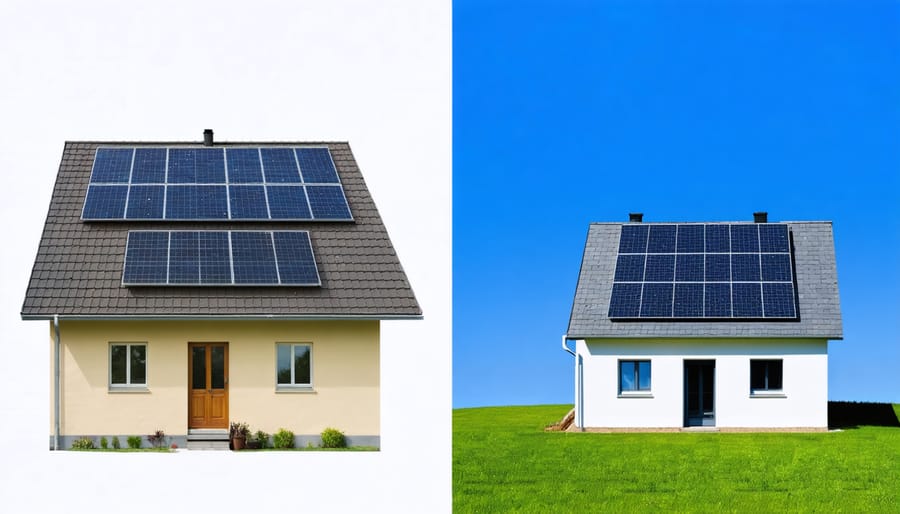
Energy Usage Optimization
To maximize your solar panel investment, implementing smart energy usage strategies is crucial. Start by conducting an energy audit to identify peak consumption periods and major energy drains in your home. Consider installing a smart meter to track your usage patterns in real-time and adjust accordingly.
Timing your energy consumption is key. Run energy-intensive appliances like washing machines, dishwashers, and pool pumps during peak sunlight hours when your panels are generating maximum power. This simple adjustment ensures you’re using solar energy directly rather than drawing from the grid.
Consider upgrading to energy-efficient appliances that complement your solar system. LED lighting, smart thermostats, and Energy Star-rated devices can significantly reduce your overall consumption, making your solar panels more effective at covering your energy needs.
Battery storage systems can help you maximize solar energy usage by storing excess power for nighttime use or cloudy days. While this requires additional investment, it can dramatically improve your system’s efficiency and increase energy independence.
Regular maintenance of your solar panels is essential for optimal performance. Keep panels clean and free from debris, check for shade from growing trees, and ensure all components are functioning correctly. Consider automated cleaning systems in dusty areas or tilting mechanisms to adjust panel angles seasonally for maximum sun exposure.
Remember to monitor your system’s performance through its monitoring app or interface, allowing you to spot and address any efficiency issues promptly.
Real Numbers: Average ROI Timeframes
Location-Based ROI Variations
The return on investment for solar panels can vary significantly depending on your geographic location, with several key factors coming into play. Sunny states like California, Arizona, and Florida naturally offer higher solar potential, allowing your panels to generate more electricity throughout the year. However, it’s not just about sunshine – local electricity rates play a crucial role too.
States with higher electricity costs, such as Hawaii, California, and Massachusetts, often see faster ROI periods because every kilowatt-hour generated represents greater savings. For example, while Arizona has more sun exposure, homeowners in Massachusetts might achieve similar ROI timeframes due to their higher local energy costs.
Local incentives and policies also create substantial regional differences. Some states offer generous tax credits, rebates, and solar renewable energy certificates (SRECs) on top of federal incentives. These location-specific benefits can significantly reduce your initial investment and accelerate your payback period.
Climate conditions affect both energy production and system requirements. In snowy regions, you might need more durable panels and snow removal systems, while coastal areas may require corrosion-resistant equipment. These location-specific considerations influence your initial investment and long-term maintenance costs.
Understanding your local solar potential, energy rates, and available incentives is crucial for calculating an accurate ROI. Consider consulting local solar installers who can provide region-specific insights and detailed ROI projections based on your exact location.

Long-Term Value Appreciation
Solar panels offer value that extends far beyond monthly energy savings. Studies consistently show that homes with solar installations increase your home’s value by an average of 4.1% compared to similar properties without solar systems. For a $400,000 home, this translates to a potential value increase of $16,400.
This appreciation in home value remains stable even as your solar panels age, making it a reliable long-term investment. Buyers are increasingly prioritizing energy-efficient homes, and solar panels have become a desirable feature in real estate listings. Many homebuyers understand that purchasing a home with an existing solar system means immediate energy savings without the hassle of installation.
Beyond property value, solar panels offer protection against rising utility costs. As electricity rates continue to climb, your solar investment becomes more valuable over time. The system also provides energy independence, reducing your reliance on the grid and protecting you from power outages when paired with battery storage.
Additionally, solar panels can last 25-30 years with minimal maintenance, making them a durable home improvement that continues to generate returns long after the initial investment has been recovered. Many homeowners find that their solar systems perform above expectations, delivering greater financial benefits than initially projected.
Common ROI Myths Debunked
Maintenance Costs vs. Returns
When evaluating solar panel investments, many homeowners worry about ongoing maintenance expenses eating into their returns. The reality is that solar panel maintenance costs are surprisingly minimal, typically ranging from $150 to $300 annually for basic cleaning and inspection services.
Modern solar panels are built to withstand various weather conditions and require little upkeep. Most maintenance involves simple tasks like removing debris and occasional professional cleaning to maintain optimal performance. These minimal costs are far outweighed by the energy savings and increased property value that solar panels provide.
The average solar system can generate returns of $1,000 to $2,000 annually in energy savings while requiring only a fraction of that amount in maintenance. Over a 25-year lifespan, maintenance expenses usually account for just 2-3% of the total system cost, making them a minor factor in the overall ROI calculation.
Many manufacturers include warranties covering potential repairs for 20-25 years, further reducing financial risk. Additionally, some solar companies offer maintenance packages bundled with installation, helping homeowners budget more effectively. When considering the substantial energy savings and environmental benefits, the minimal maintenance requirements make solar panels an increasingly attractive investment for budget-conscious homeowners.
Technology Improvements and ROI
The solar industry has seen remarkable technological advancements in recent years, directly impacting the return on investment for homeowners. Modern solar panels are significantly more efficient than their predecessors, with many residential panels now converting 20-23% of sunlight into electricity, compared to just 15% a decade ago. This improved efficiency means fewer panels are needed to produce the same amount of power, reducing initial installation costs.
Manufacturing innovations have also led to more durable panels with longer lifespans, often exceeding 25 years of reliable performance. Many manufacturers now offer warranties that guarantee at least 85% efficiency even after 25 years, providing homeowners with more predictable long-term returns.
Smart technology integration has revolutionized system monitoring and optimization. Modern solar installations include sophisticated monitoring systems that help homeowners track performance in real-time and identify potential issues before they impact energy production. These advances ensure systems operate at peak efficiency, maximizing energy generation and financial returns.
The cost of solar panels continues to decrease, with prices dropping by more than 70% over the past decade. This declining cost, combined with improved efficiency, means faster payback periods for homeowners. Additionally, new panel designs, including bifacial panels that capture reflected light, and enhanced energy storage solutions, are further improving the ROI potential of solar investments.
Investing in solar panels represents a smart financial decision that can significantly impact both your wallet and the environment. As we’ve explored, the ROI of solar panels typically ranges from 5-10 years, with system lifespans extending well beyond 25 years. The combination of reduced energy bills, tax incentives, and increased property value makes solar installation an attractive investment for homeowners.
Remember that maximizing your solar ROI depends on several key factors: proper system sizing, optimal panel placement, regular maintenance, and taking advantage of available incentives. While the initial investment may seem substantial, the long-term benefits far outweigh the costs, especially as electricity rates continue to rise.
Now is an excellent time to consider solar installation, with current federal tax credits and local incentives making the investment more affordable than ever. By taking action today, you’ll not only secure your energy independence but also contribute to a more sustainable future while enjoying significant financial returns for decades to come.
Don’t wait for energy prices to climb higher – start your solar journey by getting quotes from reputable installers and calculating your potential savings based on your specific situation.

